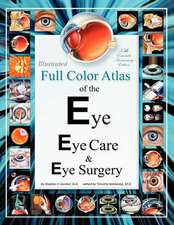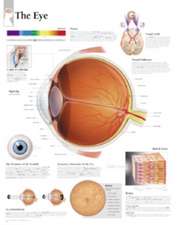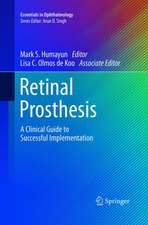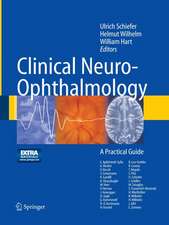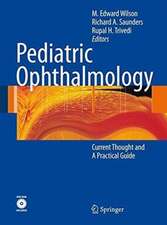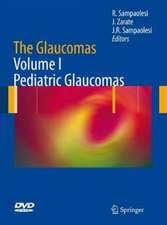Panoramic Ophthalmoscopy: Optomap Images and Interpretation
Autor Jerry Sherman, Gulshan Karamchandani, William Jones, Sanjeev Nathen Limba Engleză Hardback – 15 sep 2007
Inside Panoramic Ophthalmoscopy, Jerome Sherman, Gulshan Karamchandani, William Jones, Sanjeev Nath, and Lawrence A. Yannuzzi document and expertly explain all there is to know about this remarkable new technology. Over 500 images highlight the text, many of which have never been seen before, and provide detailed visual references for numerous eye disorders.
This colorful atlas is the ideal resource for interpreting these images and diagnosing serious eye conditions that may have otherwise gone undetected.
Panoramic Ophthalmoscopy contains an introductory chapter that highlights and contrasts panoramic ophthalmoscopy and optomap® images to all the traditional methods of fundus viewing. Inside you will find over 100 exemplary case presentations covering common and uncommon topics such as normal fundus, retinal tears, Coat’s disease, and diabetic retinopathy. Also included are cases of retinal and choroidal diseases and how they were diagnosed and managed using this technology. In the last chapter, the authors peer into the next frontier of imaging by introducing Optos fluorescein angiography and its myriad potential contributions to patient care, research, and clinical teaching.
Each case presentation includes:
- History and chief compliant
- Clinical findings
- optomap® images
- Differential diagnosis
- Disposition and follow-up
Cases are arranged into 11 chapters covering:
- Optic Disc
- Macula
- Vascular
- Inflammatory
- Mass Lesions
- Retinal Degenerations
- Peripheral Lesions
With expert descriptions and hundreds of never before seen images, the all encompassing Panoramic Ophthalmoscopy: Optomap® Images and Interpretation is the perfect resource for optometrists, ophthalmologists, ophthalmic technicians, residents, and students who would like to learn more about and would like to benefit from this revolutionary technology.
Preț: 1057.34 lei
Preț vechi: 1112.99 lei
-5% Nou
Puncte Express: 1586
Preț estimativ în valută:
202.32€ • 211.67$ • 168.07£
202.32€ • 211.67$ • 168.07£
Carte tipărită la comandă
Livrare economică 03-17 aprilie
Preluare comenzi: 021 569.72.76
Specificații
ISBN-13: 9781556427800
ISBN-10: 1556427808
Pagini: 288
Dimensiuni: 216 x 279 x 18 mm
Greutate: 1.07 kg
Ediția:First.
Editura: CRC Press
Colecția CRC Press
ISBN-10: 1556427808
Pagini: 288
Dimensiuni: 216 x 279 x 18 mm
Greutate: 1.07 kg
Ediția:First.
Editura: CRC Press
Colecția CRC Press
Public țintă
Professional Practice & DevelopmentCuprins
Contents Dedication About the Authors Contributing Authors Introduction 1. Optic Disc 1.1 Disc Lesion Shows Slow Growth Over a Decade 1.2 Routine Scan in a 6-Year-Old Reveals Brain Disorder 1.3 Finding of Decrease in Cup-to-Disc Ratio Leads to Brain Tumor Diagnosis 1.4 Visual Problems Resulting From Car Accident 1.5 Benign Brain Disorder 1.6 Differential Diagnosis of Cupping 1.7 Genetic Testing Reveals Etiology of Blindness 1.8 Blurred Disc Borders Raise Concern 1.9 An Optometrist's Sister 1.10 Trauma Evaluation Leads to Unrelated Discovery 1.11 Sinus Blindness 1.12 Pity About the Pit 2. Macula 2.1 Follow-up of Mentally Challenged Patient 2.2 Triad of Trouble In Symptomatic High School Teacher 2.3 Blindness Due to Trauma Decades Earlier 2.4 Patient with Shimmering Spots 2.5 An Octogenarian Who Has Had It All 2.6 Question of Wet Versus Dry Age-Related Macular Degeneration In Blind Octogenarian 2.7 Visual Acuity OK at Present But Fundus Findings Predict Blindness 2.8 Fuzzy 20/20 Vision 2.9 Pregnancy-Induced Maculopathy 3. Myopia 3.1 Treated Retinal Tear Patient Complains About Floaters 3.2 Multiple Temporal Tears in High Myopia 3.3 Astronomy Buff Presents with Rings of Saturn 3.4 Back Bulge aka Posterior Staphyloma 4. Vascular 4.1 Asymptomatic Hypertensive Patient Presents With Multiple Hemorrhages 4.2 Complication of Migraines or Migraine Treatment? 4.3 Retinal Disorder Due to Birth Control Pills? 4.4 Temporary Loss of Vision: Why? 4.5 Big Change in a Month 4.6 Hepatitis-Induced Retinopathy? 4.7 Multiple Therapies for Diabetic Maculopathy 4.8 Bad Disease, Bad Options, Bad Outcome 4.9 Two Systemic Diseases Result in Combined Retinopathy 4.10 Overly Aggressive Laser Treatment or Second Disease 4.11 Subtleties Missed on Routine Exam 4.12 Objective Evidence of Treatment Denied by Patient 4.13 Myriad Maladies 4.14 Worlds Longest Cilioretinal Artery? 4.15 Boy With Exudates 4.16 It Ain't Rare If It's In Your Chair 4.17 Peripheral Lesions In Both Eyes 4.18 Upper Vision \u0022A Bit Dark\u0022 4.19 Viagra-Induced Retinopathy? 5. Inflammatory 5.1 Light Sensitivity Heralds Recurrent Inflammation 5.2 Double Whammy 5.3 Giant Congenital Lesions 5.4 The Unfortunate Lesion Location 5.5 The Fortunate Missing Component of the Triad 5.6 An Optometrist With Multiple Spots 5.7 Blurry Vision Is the Tip of the Iceberg of Serious Systemic Disease 5.8 Gnat Tracks Fade Following Vitrectomy 6. Mass Lesions 6.1 Suspicious Lesion In an Asymptomatic Optometrist 6.2 Typical Nevus In Glaucoma Suspect 6.3 Large Lesion Leads to Concern 6.4 Glaucoma Screening Reveals Unrelated Disorder 6.5 Melanoma Hiding Behind Cataract 6.6 Worsening Vision Without Glasses Leads to Detection of Large Mass 6.7 Lesion de Novo in 17 Months 6.8 Asymptomatic Young Mother of Three Requires Enucleation 6.9 Routine Contact Lens Check-up Reveals Malignant Tumor 6.10 Fundus Finding Points to Metastasis 7. Detachments 7.1 Excessive Floaters Followed by Vision Loss 7.2 Shallow Retinal Detachment Without Typical Symptoms Complicates Detection 7.3 Small Hole Leads to Big Problems 7.4 Residual Retinopathy From Decade Old Trauma 7.5 A Different Form of Retinal Lattice 7.6 Silent and Progressive Vision Disorder 7.7 Ring Unrecognized by Retinal Surgeon 7.8 High-Tech Instruments Diagnose a Rare Peripheral Retinal Lesion 7.9 B-Scan Confirms Lesion Missed By BIO 7.10 Retinoschisis Plus 7.11 Kissing Choroidals 7.12 Why the Arcuate Folds? 8. Retinal Degenerations 8.1 Dialysis Patient Presents With Bizarre Retinal Disorder 8.2 Early Indication of Blindness or Just a Variant of Normal? 8.3 Unilateral Dots and Night Blindness 8.4 Retinitis Pigmentosa Complicates Glaucoma Diagnosis 8.5 Textbook Retinitis Pigmentosa 8.6 First Panoramic Fundus View of New Clinical Entity 8.7 Young Male Presented With Progressive Day and Night Vision Impairment 8.8 Doctor's Initial Panic Replaced by Acceptance 8.9 Patient Concerned About Old Red Spot After New Trauma 8.10 Vision Problem Skips a Generation 8.11 Trauma Complicates Genetic Disorder 8.12 Photophobic Patient With Nystagmus Presents With Light Flashes 8.13 This Patient Sees? 9. Vitreous 9.1 Recent, Large Floater Leads to Discovery of Disc Hemorrhage 9.2 Asteroid Hyalosis Hampers Fundus View 9.3 Poor View Complicates LASIK Evaluation 9.4 A Persistent Spot in Each Eye Prompts Exam 9.5 Doctor Documents His Own Progressive Vitreoretinal Detachment 10. Peripheral Lesions 10.1 Heart-Shaped Retinal Tear Following Lover's Spat 10.2 Concerned Patient Obtains Various Opinions About His Lattice Degeneration 10.3 Asymptomatic Male With Myriad Fundus Lesions 10.4 Asymptomatic Female With Unusual Anastomosis 10.5 Octogenarian With Eight Eye Disorders 11. The Next Frontier 11.1 Optomap FA Digital Ultra-Widefield Angiography Index
Notă biografică
Jerome Sherman, OD, FAAO is a graduate of Pennsylvania College of Optometry and currently holds the position of Distinguished Teaching Professor at the State University of New York College of Optometry and the SUNY Schnurmacher Institute of Vision Research. He practices in the private sector at the Eye Institute and Laser Center in NYC. His research interests include retina, glaucoma, and the nonglaucomatous optic neuropathies, including Lebers Hereditary Optic Neuropathy. His publications include over 625 clinical articles, research manuscripts, book chapters, two CDs, and he has recently completed two books and is working on two others. He is a founding member of the International Foundation for Optic Nerve Disease (IFOND) and the Optometric Retina Society (ORS). Fortunately, he still enjoys travel and has presented over 100 lectures last year in myriad states and countries.
Ms. Gulshan Karamachandani graduated magna cum laude from North Carolina State University, where she majored in Biology with a concentration in nutrition. Her experiences as a technician at Cary Optometric Center (NC) and the Eye Institute and Laser Center (NY), along with her research at SUNY College of Optometry, influenced her decision to pursue a career in optometry. Currently, she is enrolled at Pennsylvania College of Optometry, class of 2010.
William L. Jones, OD, FAAO graduated from the University of Houston College of Optometry. Currently, he is the President of the Optometric Retina Society. He has held numerous previous titles including: Adjunct Professor (University of Houston College of Optometry), Adjunct Associate Professor (Southern California College of Optometry and Pacific University College of Optometry), and Assistant Clinical Professor (University of California School of Optometry). Currently, he is in private practice—New Mexico Eyecare—in Albuquerque, NM. He has written over 50 papers and articles on retinal and other eye diseases, given over 200 lectures, written chapters for optometry textbooks, and written a book in its third edition on the peripheral retina. He is also a consultant to Optos, plc.
Sanjeev Nath, MD is surgeon director of the Eye Institute and Laser Center in New York City. Continuing in the footsteps of his father and grandfather, he founded this center with state-of-the-art ophthalmic technology almost a quarter century ago. The center has always been at the forefront in utilizing the most modern diagnostic and therapeutic technologies for delivering high-tech clinical patient care. He performs virtually all types of ophthalmic laser and surgical procedures of the anterior and posterior segments of the eye in addition to numerous cosmetic procedures. He has been instrumental in teaching many clinicians the use of laser technology as well as disseminating the newest therapies in underprivileged countries. His interests span multiple aspects of ophthalmology with a special emphasis on glaucoma, including diagnosis of complex coexisting intraocular disorders, as well as therapeutic and surgical management using the newest technologies. During the last 25 years, he has had multiple presentations in clinical research to his credit. He is an attending surgeon at the New York Eye and Ear Infirmary.
Lawrence Yannuzzi, MD is a graduate of Harvard College and Boston University Medical School, where he was honored as a distinguished alumnus. He is a professor of clinical ophthalmology at Columbia University Medical School; vice-chairman and director of The Retinal Research Center of the Manhattan Eye, Ear & Throat Hospital; and founder and president of The Macula Foundation, Inc. He is a world-renowned retinal specialist who has published more than 300 scientific papers and 11 textbooks, with particular interest in diseases of the macula, such as diabetic retinopathy and age-related macular degeneration. He has also been given awards and distinctions in his field for contributions on retinal imaging, drug development, ophthalmic laser, and the diagnosis and treatment of macular and retinal diseases. Most recently, he was given an honorary doctorate at the University of Ancona, the Michelson Award for Retinal Vascular Disease in Gent, the Alcon Research Institution Award, a distinguished alumnus award at Boston University, and a lifetime achievement award by the American Academy of Ophthalmology.
Ms. Gulshan Karamachandani graduated magna cum laude from North Carolina State University, where she majored in Biology with a concentration in nutrition. Her experiences as a technician at Cary Optometric Center (NC) and the Eye Institute and Laser Center (NY), along with her research at SUNY College of Optometry, influenced her decision to pursue a career in optometry. Currently, she is enrolled at Pennsylvania College of Optometry, class of 2010.
William L. Jones, OD, FAAO graduated from the University of Houston College of Optometry. Currently, he is the President of the Optometric Retina Society. He has held numerous previous titles including: Adjunct Professor (University of Houston College of Optometry), Adjunct Associate Professor (Southern California College of Optometry and Pacific University College of Optometry), and Assistant Clinical Professor (University of California School of Optometry). Currently, he is in private practice—New Mexico Eyecare—in Albuquerque, NM. He has written over 50 papers and articles on retinal and other eye diseases, given over 200 lectures, written chapters for optometry textbooks, and written a book in its third edition on the peripheral retina. He is also a consultant to Optos, plc.
Sanjeev Nath, MD is surgeon director of the Eye Institute and Laser Center in New York City. Continuing in the footsteps of his father and grandfather, he founded this center with state-of-the-art ophthalmic technology almost a quarter century ago. The center has always been at the forefront in utilizing the most modern diagnostic and therapeutic technologies for delivering high-tech clinical patient care. He performs virtually all types of ophthalmic laser and surgical procedures of the anterior and posterior segments of the eye in addition to numerous cosmetic procedures. He has been instrumental in teaching many clinicians the use of laser technology as well as disseminating the newest therapies in underprivileged countries. His interests span multiple aspects of ophthalmology with a special emphasis on glaucoma, including diagnosis of complex coexisting intraocular disorders, as well as therapeutic and surgical management using the newest technologies. During the last 25 years, he has had multiple presentations in clinical research to his credit. He is an attending surgeon at the New York Eye and Ear Infirmary.
Lawrence Yannuzzi, MD is a graduate of Harvard College and Boston University Medical School, where he was honored as a distinguished alumnus. He is a professor of clinical ophthalmology at Columbia University Medical School; vice-chairman and director of The Retinal Research Center of the Manhattan Eye, Ear & Throat Hospital; and founder and president of The Macula Foundation, Inc. He is a world-renowned retinal specialist who has published more than 300 scientific papers and 11 textbooks, with particular interest in diseases of the macula, such as diabetic retinopathy and age-related macular degeneration. He has also been given awards and distinctions in his field for contributions on retinal imaging, drug development, ophthalmic laser, and the diagnosis and treatment of macular and retinal diseases. Most recently, he was given an honorary doctorate at the University of Ancona, the Michelson Award for Retinal Vascular Disease in Gent, the Alcon Research Institution Award, a distinguished alumnus award at Boston University, and a lifetime achievement award by the American Academy of Ophthalmology.
Descriere
Panoramic Ophthalmoscopy: Optomap® Images and Interpretationcomprehensively covers the state-of-the-art technology and the high-resolution digital images taken with the Panoramic200 Scanning Laser Ophthalmoscope.





